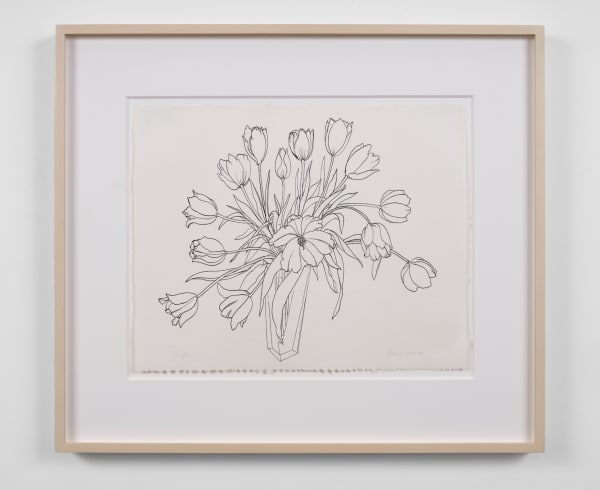Ruth Asawa 1926-2013
"I am able to take a wire line and go into the air and define the air without stealing from anyone. A line can enclose and define space while letting the air remain air."
Ruth Asawa was an American artist known for her intricate sculptures based on sinuous organic forms. Using galvanized wire, stone, and bronze, Asawa crafted nest-like works inspired by native Mexican basket-weaving techniques. “I was interested in it because of the economy of a line, making something in space, enclosing it without blocking it out. It’s still transparent,” she said of her materials. “I realized that if I was going to make these forms, which interlock and interweave, it can only be done with a line because a line can go anywhere.”
Born on January 24, 1926 in Norwalk, CA to Japanese immigrants, her early life was blighted by her family’s detainment in a Japanese-American internment camp during World War II. After the war, Asawa left California in pursuit of a teaching degree from Milwaukee State Teachers College. Met by discrimination in Milwaukee, the artist abandoned her teaching degree and ventured to Black Mountain College in Asheville, NC. While at Black Mountain College, she studied under prominent artists such as John Cage, Josef Albers, Buckminster Fuller, and Merce Cunningham.
Today, the artist’s works are in the collections of The Museum of Modern Art in New York, the J. Paul Getty Museum in Los Angeles, and the de Young Museum in San Francisco.
Born in rural California, American sculptor, educator, and arts activist Ruth Asawa (1926–2013) was first exposed to professional artists while her family and other Japanese Americans were detained at Santa Anita, California, in 1942. Following her release from an internment camp in Rohwer, Arkansas, eighteen months later, she enrolled in 1943 in Milwaukee State Teachers College.
Unable to receive her degree due to continued hostility against Japanese Americans, Asawa left Milwaukee in 1946 to study at Black Mountain College in North Carolina, then known for its progressive pedagogical methods and avant-garde aesthetic environment. Asawa’s time at Black Mountain proved formative in her development as an artist, and she was particularly influenced by her teachers Josef Albers, Buckminster Fuller, and the mathematician Max Dehn. She also met architectural student Albert Lanier, whom she would marry in 1949 and with whom she would raise a large family and build a career in San Francisco. Asawa continued to produce art steadily over the course of more than a half century, creating a cohesive body of sculptures and works on paper that, in their innovative use of material and form, deftly synthesizes a wide range of aesthetic preoccupations at the heart of twentieth-century abstraction.
Asawa’s work has been exhibited widely since the early 1950s, including early solo exhibitions at Peridot Gallery, New York in 1954, 1956, and 1958. In 1965, Walter Hopps organized a solo exhibition of the artist’s sculptures and drawings at the Pasadena Art Museum (now Norton Simon Museum) in California, where the artist completed a residency at the Tamarind Lithography Workshop the same year. Other solo presentations include those held at the San Francisco Museum of Art (1973); Fresno Art Museum, California (traveled to Oakland Museum of California; 2001-2002); de Young Museum, San Francisco (2006); Amon Carter Museum of American Art, Fort Worth, Texas (2012); and Norton Simon Museum of Art, Pasadena, California (2014).
In 2018-2019, the Pulitzer Arts Foundation in St. Louis presented Ruth Asawa: Life’s Work, the first major museum exhibition of the artist’s work in more than a decade. An accompanying catalogue published by Pulitzer Arts Foundation and Yale University Press includes essays by Aruna D’Souza, Helen Molesworth, and Tamara H. Schenkenberg. In 2020-2021, Ruth Asawa: Citizen of the Universe will open at Modern Art Oxford, England, and will subsequently travel to the Stavanger Kunstmuseum, Norway (2021).
The artist’s works have also been included in significant group exhibitions, including Leap Before You Look: Black Mountain College 1933–1957, Institute of Contemporary Art, Boston (2015; traveled to Hammer Museum, Los Angeles, and Wexner Center for the Arts, Columbus, Ohio); America is Hard to See, Whitney Museum of American Art, New York (2107); Revolution in the Making: Abstract Sculpture by Women, 1947–2016, Hauser & Wirth, Los Angeles (2017); Making Space: Women Artists and Postwar Abstraction, The Museum of Modern Art, New York (2017); The Pencil is a Key: Drawings by Incarcerated Artists, The Drawing Center, New York (2019); and In a Cloud, in a Wall, in a Chair: Six Modernists in Mexico at Midcentury, Art Institute of Chicago (2019).



